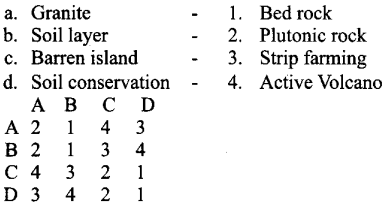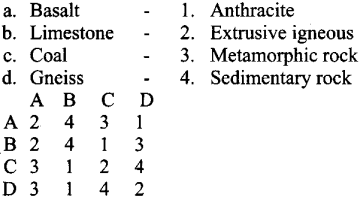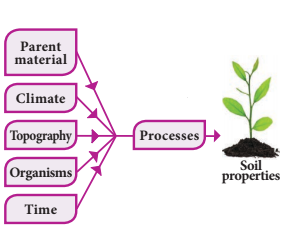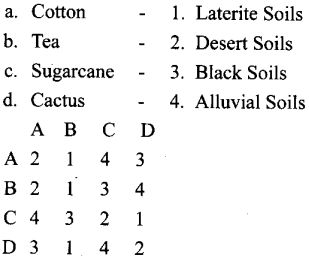Tamilnadu State Board New Syllabus Samacheer Kalvi 8th Social Science Guide Pdf Geography Chapter 1 Rocks and Soil Text Book Back Questions and Answers, Important Questions, Notes.
Tamilnadu Samacheer Kalvi 8th Social Science Solutions Geography Chapter 1 Rocks and Soil
Samacheer Kalvi 8th Social Science Rocks and Soil Text Book Back Questions and Answers
I. Choose the correct answer:
1. Which of the following is known as sphere of rocks
a) Atmosphere
b) Biosphere
c) Lithosphere
d) Hydrosphere
Answer:
(c) Lithosphere
2. World soil day is observed on
a) 15th August
b) 12th January
c) 15th October
d) 5th December
Answer:
(d) 5th Decembe
3. Fossils are found in
a) Sedimentary rocks
b) Igneous rocks
c) Metamorphic rocks
d) Plutonic rocks
Answer:
(a) Sedimentary rocks
![]()
4. The top layer of soil is called as
a) organic layer or humas
b) topsoil
c) subsoil
d) bedrock
Answer:
(b) topsoil
5. Ideal soil for growing cotton is
a) Red soil
b) Black soil
c) Alluvial soil
d) Mountain soil
Answer:
(b) Black soil
6. The major components of soil is
a) Rocks
b) Minerals
c) Water
d) All the above
Answer:
(b) Minerals
7. Which one of the following is the most widespread most and productive category of soil
a) Alluvial soil
b) Black soil
c) Red soil
d) Mountain soil
Answer:
(a) Alluvial Soil
II. Fill in the blanks.
1. Scientific study of rocks is called …………….
Answer:
Petrology
2. ……………. soil is highly suitable for millets cultivation.
Answer:
Black
3. The “Skin of earth” is
Answer:
Soil
4. ……………. is the kind of metamorphic rock using which Taj Mahal was built.
Answer:
White marble
5. ……………. is known as the primary rocks.
Answer:
Igneous rock
True or False:
1. Igneous rocks are called primary rocks.
Answer:
True
2. Slate is formed from shale.
Answer:
True
3. Red soil is formed by the process of leaching.
Answer:
False
4. M-sand is used as alternative for natural sand in construction.
Answer:
True
5. Volcanic mountains are covered with sedimentary rocks.
Answer:
True
IV. Match the following:
1.

Answer:
A) 2 14 3
![]()
2.

Ans: D) 3, 1, 4, 2
V. Choose the incorrect statement from the following:
1. a) Igneous rocks are called the primary rocks.
b) Soil is the product of weathering of rocks.
c) Sedimentary rocks are the hardest ones.
d) Deccan plateau is the region of Igneous rocks.
Answer:
d) Deccan plateau is the region of Igneous rocks.
2. a) Soil erosion decreases its fertility.
b) Dynamic metamorphism is caused by high temperature.
c) Soil is a renewable source.
d) Humus is a part of the top layer of soil.
Answer:
c) Soil is a renewable source.
VI. Consider the. following statements and choose the right option from the given ones:
Statement (1): Sedimentary rocks consist of many layers.
Statement (2) : Sedimentary rocks are formed by the sediments deposited at different points of time.
(a) 1 and 2 are correct and 2 explains 1
(b) 1 and 2 are correct but, 2 does not explain 1
(c) 1 is correct but, 2 is incorrect
(d) 2 is correct but, 1 is incorrect.
Answer:
(a) 1 and 2 are correct and 2 explains 1
VII. Give reasons for the following:
1. Chemical sedimentary rocks are found in the beds of reservoirs.
Answer:
Chemical Sedimentary rocks are formed by the precipitating minerals from water. It is formed usually through the evaporation of chemical-rich solutions.
2. Igneous rocks are found in the regions of volcanoes
Answer:
The formation of igneous rocks takes place when there is an outflow of molten magma.
VIII. Distinguish the following:
1. Metamorphic rock and sedimentary rock.
| Metamorphic rocks | Sedimentary rocks | |
| i) | A rock formed by the alteration of igneous and sedimentary rocks subject to the high temperature and pressure is called metamorphic rocks. | Due to high temperature and pressure, the undisturbed sediments of long period is cemented to form sedimentary rocks. |
| ii) | Metamorphism is of two types: a) Thermal Metamorphism and b) Dynamic Metamorphism. |
Sedimentary rocks are of three types: a) Organic Sedimentary rocks, b) Mechanical Sedimentary rocks and c) Chemical Sedimentary rocks. |
2. Soil conservation and Soil erosion.
| Soil conservation | Soil erosion | |
| i) | The process of protecting the soil from erosion to maintain its fertility. | The removal or destructive of the top layer of soil by natural forces and human activities. |
| ii) | Practised for the conservation of afforestation, controlled grazing, construction of dams, crop rotation, wind break, etc. | Reduces the fertility of soil which leads to the reduction in the agricultural productivity. |
IX. Give short answers
1. How are igneous rocks formed?
Answer:
The igneous rocks are formed by the solidification of molten magma.
2. Describe about the composition of soil.
Answer:
- The basic components of soil are mineral, organic matter, water and air.
- It consists of about 45% mineral, 5% organic matter, 25% of water, and 25% air.
- The composition of soil varies from place to place and from time to time.
![]()
3. Define ‘rock’.
Answer:
- The rocks are the solid mineral materials forming a part of the surface of the earth and other similar planets.
- A rock is an aggregate of one or more minerals. Rock is an important natural resource and is found in solid-state.
- It may be hard or soft in nature.
4. State the types of soils.
Answer:
- Alluvial soil
- Black soil
- Red soil
- Laterites soil
- Mountain soil
- Desert soil
5. What is soil conservation?
Answer:
Soil conservation is the process of protecting the soil from erosion to maintain its fertility.
X. Give a detailed answer for the following:
1. Explain the process of soil formation.
Answer:
Soil and its Formation:

Igneous:
(i) The igneous rocks are formed by the solidification of molten magma. Also called Primary or Parent Rocks.
(ii) Types:
- Extrusive Igneous Rocks.
- Intrusive Igneous Rocks
1. Extrusive Igneous Rocks:
Molten magma which comes out from the interior of the earth’s surface gets solidified and forms such rocks. Fine-grained and glassy in nature. Eg., Basalt, found in northwestern peninsular India.
2. Intrusive Igneous rocks:
Molten magma cools down deep inside the earth’s crust, becomes solid and forms such rocks. Form large grains. Deep seated rocks are plutonic rock and ones at shallow depths – Hypabysal rocks. Example Granite, Diorite.
Sedimentary:
(i) Formed by the sediments derived and deposited by various agents. Also called stratified rocks.
(ii) Types:
- Organic sedimentary rocks
- Mechanical sedimentary rocks,
- Chemical sedimentary rocks
1. Organic sedimentary rocks:
Formed due to decomposition of dead Plants and Animals. Contains fossils. Example Chalk, Talc
2. Mechanical sedimentary rocks:
Formed from the disintegration of Igneous and metamorphic rocks. Get deposited due to erosion by natural agents. Get cemented after a long time to form rocks. Example Sandstone, Shale.
3. Chemical sedimentary rocks: Formed by precipitating of minerals from water. Formed due to evaporation of chemical rich solution. Example Rock Salt.
Metamorphic:
(i) Formed when Igneous and sedimentary rocks are subjected to high temperature and pressure.
(ii) Types:
- Thermal
- Dynamic
1. Thermal Metamorphic:
If the change in rocks is caused by high temperature.
2. Dynamic Metamorphic:
If the change in rock is caused by high pressure. Formed from Igneous rocks. Eg., Granite into gneiss
Formed from Sedimentary rocks. Eg., Shale into Slate
![]()
3. Give an account of different layers of soil.
Layers of soil:
O – Horizon or humus:
This layer is dominated by organic material eg: leaves
A – Horizon or Topsoil:
It is a part of topsoil composed of organic matter mixed with mineral matter.
E – Horizon or Elevated layer:
E – stands for the elevated layer. This layer is significantly leached of clay, iron and aluminium oxides, which leaves a concentration of ore.
B – Horizontal or subsoil:
This layer reflects the chemical or physical alternation or parent material. Thus iron, clay, aluminium and organic compounds are found accumulated in the Horizon.
C – Horizon or Parent Rock:
Partially weathered parent material accumulates in this layer.
R – Horizon or Parent Rock:
This layer consists of an unweathered part of the bedrock.
4. Classify and explain the soil?
Answer:
Definition: Soil is a mixture of Organic matter, minerals, gases, liquids, and organisms that together support life.
Classification of soils:
Soils are classified on the basis of their formation, colour, physical and chemical properties. Based on these, soil is classified into six major types. They are Alluvial soil, Black soil, Red soil, Laterite soil, Mountain soil, Desert soil.
Alluvial soil:
- Found in the regions of river valleys, flood plains, and coastal regions.
- Formed by the deposition of silt by the running water.
- Most productive of all soils.
- Suitable for the cultivation of sugarcane, jute, rice, wheat.
Black soils:
- Formed by weathering of igneous rocks.
- Clayey in nature.
- Retains moisture.
- Ideal for growing cotton.
Red Soils:
- Formed by weathering of metamorphic rocks and crystalline rocks.
- Found in semi-arid regions.
- Not a fertile.
- Is soil brown-red in colour due to the presence of iron oxide
- Suitable for millet cultivation.
Laterite soils:
- Formed by the process of leaching.
- Found in trophical regions, which experienced the alternate wet and dry conditions.
- Infertile soil.
- Suitable for plantation of tea and coffee.
Mountain soils:
- Found in slopes of mountains.
- Thin and acidic in nature.
- The nature of soil differs based on the altitude.
Desert soils:
- Found in the hot desert region.
- Porous and saline in nature.
- Infertile in nature.
- Agriculture is not successful.
XI. Activity Corner.
1. Complete the following table with the help of an internet source.

Samacheer Kalvi 8th Social Science Rocks and Soil Additional Important Questions and Answers
I. Choose the Correct answer.
1. Petrology is derived from the ………….. word.
a) English
b) Latin
c) Greek
d) French
Answer:
(c) Greek
2. The soils found in the desert regions are …………..
a) Mountain Soils
b) Desert Soils
c) Black Soil
d) Red Soil
Answer:
(b) Desert Soils
3. Which Soils are formed by the weathering of metamorphic rocks?
a) Red Soils
b) Rock Soils
c) Laterite Soils
d) Mountain Soils
Answer:
(a) Red Soils
4. …………….. is a part composed of organic matter mixed with mineral matter.
a) Humus
b) Top Soil
c) Elevated layer
d) Sub-soil
Answer:
(b) Top Soil
5. The time to form one cm of soil is
a) 100 years
b) 200 years
c) 500 years
d) 1000 years
Answer:
(b) 200 years
6. …………….is known as the zone of accumulation.
a) Humus
b) Top Soil
c) Elevated layer
d) Sub-soil
Answer:
(d) Sub-soil
7. In the soil composition ………….. are minerals.
a) 5%
b) 10%
c) 25%
d) 45%
Answer:
(d) 45%
8. In the soil composition is air.
a) 5%
b) 10%
c) 25%
d) 40%.
Answer:
(c) 25%
9. ……………. soils are formed by the deposition of silt by the running water.
a) Black
b) Red
c) Alluvial
d) Desert
Answer:
(c) Alluvial
10. the Soil composition is organic matter.
a) 5%
b) 10%
c) 25%
d) 45%
Answer:
(a) 5%
II. Fill in the blanks:
1. A rock is an aggregate of ………….. or more minerals.
Answer:
one
2. There are ………….. different types of minerals found on the earth Surface.
Answer:
2000
![]()
3. Rocks are classified in to ………….. types.
Answer:
three
4. The two types of Intrusive Igneous rocks are ………….., …………..
Answer:
Plutonic rocks, Hypabysal rocks
5. Igneous Rocks are ………….. rocks
Answer:
Primary
6. ……………. into slate caused by thermal metamorphism.
Answer:
Basalt
7. Soil is a basic requirement for the growth of ………….. and …………..
Answer:
Plants, animals
8. To become a well-matured soil, it takes about ………….. years.
Answer:
3000
9. Parent Rock is converted to loose Rock by ……………
Answer:
soil
10. Laterite soil is suitable for plantation crops like ………….., …………..
Answer:
tea, coffee
III. State whether the following statements are true or false:
1. To become a well-matured soil, it taken about 2000 years.
Answer:
False
2. Lava comes out from a volcano.
Answer:
True
3. The word Ignis means rock.
Answer:
False
4. Oldest Sedimentary rocks of the world has been identified in Green land.
Answer:
True
5. Soil supports ecosystem and play an important role in land management.
Answer:
True
IV. Match the following:
1.

Answer:
D) 3 1 4 2
V. Choose the incorrect statement from the following:
1. a) Basalt into slate caused by thermal metamorphism.
b) Chemical Sedimentary rocks are also called evaporates.
c) Taj Mahal in India was built with white marbles of Sedimentary rocks.
d) Rocks have been used by mankind throughout history.
Answer:
c) Taj Mahal in India was built with white marbles of Sedimentary rocks.
VI. Consider the following statements and choose the right option from the given ones:
1. Statement (1): Petrology is a branch of geology.
Statement (2): It deals with the Study of water researches.
a) 1 and 2 are correct and 2 explains 1
b) 1 and 2 are correct but, 2 does not explain 1
c) 1 is correct but, 2 is incorrect
d) 2 is correct but, 1 is incorrect.
Answer:
c) 1 is correct but, 2 is incorrect
VII. Give reasons for the following:
1. Why soil is known as ‘Skin of the earth’?
- Soil minerals form the basis of soil.
- It forms on the surface of the earth.
- so It is known as the ‘Skin of the earth’:
VIII. Distinguish the following:
1. Black Soil and Red Soil.
| Black Soil | Red Soil | |
| 1. | These Soils are formed by the weathering of igneous rocks. | These soils are formed by the weathering of metamorphic rocks and crystalline rocks. |
| 2. | It is retentive of moisture. | Iron Oxide is present. |
| 3. | It is ideal for growing cotton. | It is Suitable for millet cultivation. |
IX. Give short answers:
1. Explain about Petrology.
- Petrology is a branch of geology which deals with the study of rocks.
- ‘Petrology’ is derived from the Greek word “Petrus” refers to rock and “Logos” refers to study
2. Name the layer in the Earth.
The layer found in the Earth are namely
- Lithosphere
- Hydrosphere
- Atmosphere
- Biosphere.
![]()
3. Explain the type of Igneous Rocks.
- Extrusive Igneous Rocks
- Intrusive Igneous Rocks.
X. Give a detailed answer for the following:
1. What are the uses of soil?
Answer:
Soil is one of the important natural resources. It is a basic requirement for plant growth and supports various life forms on the earth.
- The minerals present in the soil enhance and nourishes the crops and plants.
- It is used in the making of ceramics or pottery.
- It is a source of material for construction and handicraft works.
- It acts as a natural filter of water and purifies it.
- Soil supports the ecosystem and plays an important role in land management.